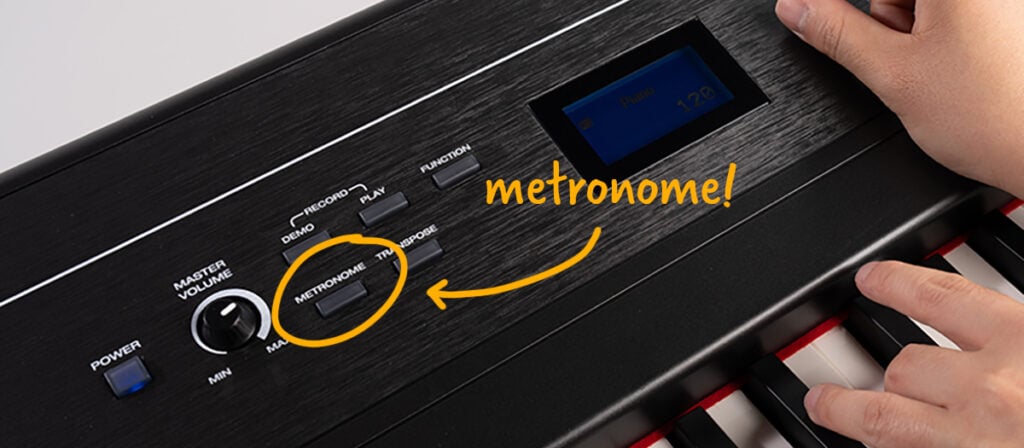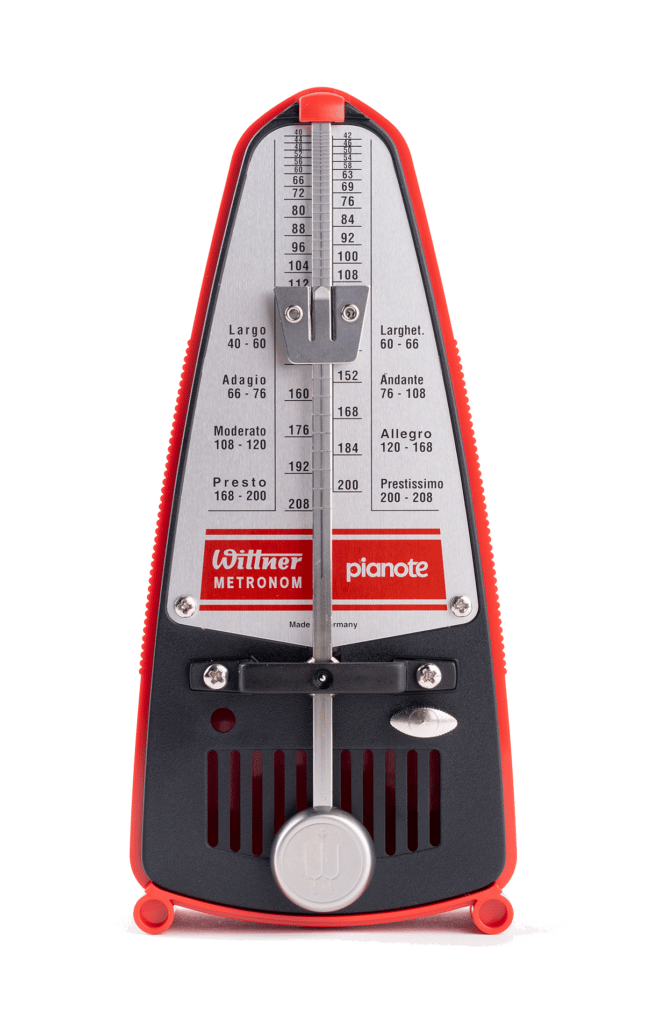The metronome is kind of a dreaded tool among piano players. That clicking sound can be, well…obnoxious. But metronomes can really, really make you become a better pianist! In this lesson, we’ll teach you how to use a metronome to help you progress with as little frustration as possible.
Table of Contents:
Get exclusive interviews, fascinating articles, and inspiring lessons delivered straight to your inbox.
A metronome is a music practice tool that sounds a steady beat. This beat can be adjusted faster or slower based on the musician’s preference.

Think you don’t have a metronome? You probably do. Metronomes are so useful that you either already have one or you can easily find one for free. So, there’s no excuse not to use one—ha!
If you want to buy your own dedicated metronome, here’s a pro tip: make sure you like the sound! Being stuck with an obnoxious click won’t motivate you to practice, so shop carefully!
The Pianote Wittner Metronome
Introducing one of our favorite products ever: the branded Pianote metronome!
It looks so good, you’ll want to use it.
This metronome is a collaboration with Wittner, the prestige metronome maker. Hand-wound and battery-free, the precision German manufacturing will keep you playing in time for years to come. In fact, this product comes with a 2-year guarantee!

Here’s how to use a metronome without throwing it against the wall:
People underestimate how hard staying true to a metronome can be. In fact, slower tempos can be trickier than fast ones!
So, set a tempo like 60bpm. Listen to the click and feel it in your body.
Then, try playing a simple scale (in our video, I play G major) and match each click with each note. It’s harder than it looks!
Now that we’ve gotten to know our metronome, let’s find our perfect practice tempo.
This is a tempo you’re already comfortable with. See if you can play without any mistakes in this tempo. If you can’t, that means you’re going too fast! And be sure to practice with your hands together. That’s the real test.
Once you can tackle one tempo perfectly, speed it up by 3-5bpm. Then get comfortable with that rhythm before moving up.
Be patient. It might feel like a slow process, but if you jump ahead and play at a tempo you’re not ready for, it can be even more frustrating. So take your time.
Sometimes, playing two notes per beat can be easier than one note per beat.
So, try playing a scale in eighth notes, which means playing two notes per click. Then, try doubling that and play sixteenth notes. That’s four notes per click.
Another fun one to try is triplets. That’s three notes per click!
If playing four notes per click is tricky, you can try the reverse: double the metronome’s tempo and play two notes per click.
We’re all different. Some of us will feel comfier this way. So, experiment and see what feels best for you. Your preference may even change depending on the song and/or time signature!

Now let’s try applying our metronome skills to a song. Look at the time signature first. For example, if we’re looking at Christian Petzold’s “Minuet in G Major” (a classic), you’ll see the time signature is 3/4. This means there are three quarter notes per measure and a quarter note equals one beat.
Most sheet music will have a “suggested tempo” with a metronome marking in the top left corner. It’ll have a note value, an equal sign, and a number (eg. “145”). This means with every click at 145, you play one quarter note.
This will probably feel way too fast.
But don’t panic. Slow it way down to a tempo you’re comfortable with and then gradually work up to that suggested tempo.
Using a metronome for 4/4 or 3/4 is pretty straightforward, but what about a time signature like 6/8?
Let’s take “Hallelujah.” It’s in 6/8. The rhythmic feel of this song is 1-2-3, 4-5-6 with a slight emphasis on the 1 and 4. So, we’ll set our metronome so that we get a click on the 1 and the 4. A good tempo for this song is 60bpm.
Again, if this doesn’t feel fantastic, you can multiply the metronome speed to 120 and play one note per click. Then, when that feels good, go back to 60 and play with those accented beats.
Tempo in Other Languages
Fancy tempo words are some of the first music terms you’ll learn. Traditionally, many of these words are Italian, French, or German.
| Tempo | Italian | German | French |
|---|---|---|---|
| Slow | Largo | Langsam | Lent |
| Moderate | Moderato | Mäßig | Modéré |
| Fast | Allegro | Schnell | Vite |
Believe it or not, metronomes aren’t just for student musicians. The pros use them…probably even more than us. More ways to use a metronome:
We hope this lesson helps you become better friends with your metronome! Happy practicing 🙂
The metronome is like your musical GPS. It keeps you on the right track and makes sure you get to your destination in perfect time.
Lisa Witt
The best way to learn piano is with real teachers, but not everyone has the time and money for a private instructor. At Pianote, you can get real feedback from real experts…all from the comfort of your own home. Explore our Method and community yourself with a free 7-day trial.
TRY PIANOTE FOR 7 DAYSLisa Witt has been teaching piano for more than 20 years and in that time has helped hundreds of students learn to play the songs they love. Lisa received classical piano training through the Royal Conservatory of Music, but she has since embraced popular music and playing by ear in order to accompany herself and others. Learn more about Lisa.
/marketing/pianote/lead-gen/getting-started/coach.webp)
/marketing/pianote/lead-gen/getting-started/logo.webp)
By signing up you’ll also receive our ongoing free lessons and special offers. Don’t worry, we value your privacy and you can unsubscribe at any time.
We use cookies for traffic data and advertising. Cookie Policy »